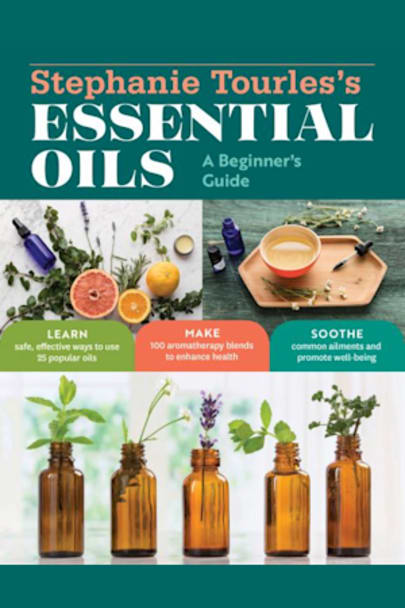Interest in and sales of essential oils are growing rapidly, but many users lack adequate knowledge on how to use these concentrated herbal extracts safely and effectively. Stephanie Tourles, best-selling author of Organic Body Care Recipes, brings her expertise to the topic with this friendly beginner’s guide. Focused on the 25 most versatile oils, Tourles provides a basic profile of the … the benefits and properties of each. Recipes show how to use the oils to make remedies to treat common ailments such as anxiety, bruises, burns, headaches, and more.
more



I really enjoyed reading some of Ms Tourles’ creative recipes. As a practicing clinical aromatherapist I want to point out a few areas that I have a differing opinion on:
*the recommendation of leaving an essential oil out on a piece of paper for 5-24 hours to see if it has been diluted. Tenacious essential oils, like the resins, and some absolutes can leave behind a residue on paper for days or weeks so this is not a universal test.
*diluting in a bath or foot bath, she recommends using certain ingredients which do not achieve a dispersion of essential oils in water and will leave the user vulnerable to contact with undiluted essential oils: cream, salt, milk, honey, and glycerin.
*in key recipes she has the user “diluting” essential oils in water or water-based ingredients like vinegar. Essential oils and water do not mix and these recipes would need a dispersant to be skin-safe.
*Tourles’ statement that the sweat glands in the feet make good entry points for essential oils is not based on anatomy and physiology or pharmacokinetics. In 1967 Feldmann and Maibach found that pores in the feet made the feet the poorest absorption site on the body.
Unfortunately due to the number of safety issues the only persons I would recommend this book to would be those who have a foundation in aromatherapy (at least 32 hours of approved study) and are up to date with safety data.
Thank you to Net Galley and the publishers for the opportunity to read this advanced review copy.
I have been using and studying essential oils for about the last 3 years and I’ve found that the more information I can get the better I can help others with those oils. Because of that, I have a growing library of books written in and out of the USA as well as books written before the FDA required compliance regarding what can be said about what oils can do or cure. I jumped at the opportunity to review Stephanie Tourles’s Essential Oils: A Beginner’s Guide to be released in August 2018.
This book is truly a beginner’s guide to essential oils in the post positive meaning of the phrase. The author starts at step one and explains what essentials oil are, their extraction methods, quality, safety, storage, and ways to use oils. I like that she is very clear about how to read the label of the oils to determine quality and origin.
The author gives a list of essential oil companies in the back of the book. I’m always disappointed when I don’t see Young Living in a list because they don’t outsource their oils as many other companies do and their products are all organically farmed. Check out Seed to Seal dot com for more information.
The author then profiles her 11 top essential oils: German chamomile, Roman chamomile, clove bud, eucalyptus, geranium, lavender, lemon, peppermint, rosemary, tea tree, and thyme. With each of these oils, she gives a history of the oil and safety guidelines for using it. She then gives a few recipes highlighting that particular oil.
She continues by highlighting an additional 14 essential oils: bergamot, cardamom, cedarwood, cinnamon bark, cypress, balsam fir, frankincense, ginger, grapefruit, helichrysum, sweet marjoram, myrrh, sweet orange, and Scotch pine.
The next section of the book, Tourles educates on base or carrier oils, herb-infused oils, and other blending ingredients. She discusses necessary tools for making essential oil recipes. Finally, she has a list of essential oil resources and reading resources.
I recommend Stephanie Tourles’s Essential Oils: A Beginner’s Guide for essential oil education and for the over 100 aromatherapy blends and helpful recipes. It’s a great reference for both oil newbies and for general essential oil education.
This book is a fabulous resource for beginners like me. It contains clear, concise descriptions of the 25 most-useful essential oils, including uses, safety considerations and a variety of recipes for making various remedies, balms, scents and other useful concoctions. Can’t wait to try some of these out!
*Thanks to NetGalley for the ARC, provided by the author and/or the publisher in exchange for an honest review.